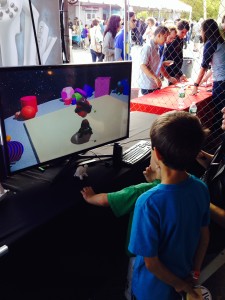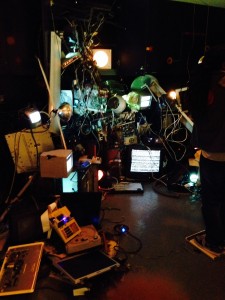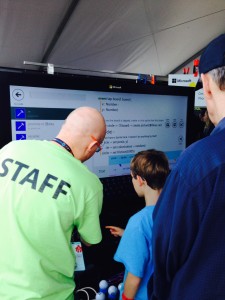At maker faire, hidden amongst the 3d printers and food trucks, there were three major interfaces that caught my eye as pushing forward in the direction that interactive technology seems to be heading. The first was at the Microsoft tent. I was drawn to the touchscreen technology they were demoing, originally because of how intuitive the painting application seemed. However, it was the touch screen programing IDE that really caught my attention. It’s layout was very readable and the code hinting buttons seemed simple enough for even the youngest users. Still I was skeptical as to whether or not it could bridge the gap between IDE’s that hold the user’s hand too tightly and IDE’s that overwhelm the user with the big picture of their code. At this stage, it looked like a good learning tool, but showed practical application when coding on tablets and smartphones, producing content for the platforms themselves. I think it was very enlightening to see users who had never coded before, using the IDE. It gave me a sense of how users begin to understand logic systems.
The next interface that inspired me was the tech demonstration from SIx Axis. They were showing remote tracking technology with both rotation and translation of the input device. Although I already knew that this type of interface existed, I didn’t know how precise it could be. I watched a user manipulate 3d objects in a loosely structured building application. They seemed capable of clicking small buttons on a 3d gui, while equally able to manipulate the camera, grab and scale objects, and exchange them from one hand to the other. The disadvantage was that technology was not yet practical enough to justify replacing a mouse and keyboard for interfaces like this. It seemed similar to what Leap Motion is trying to accomplish, with the limitations of needing physical remote controls. I was really inspired by their efforts to add depth to screen interfaces, at least from an interactive standpoint.
The last “interface” that caught my eye was an installation built from a pressure sensor outputting sound and video to a pile of electronics that ranged in age. The idea was to overwhelm the viewer with light, noise, and static patterns, whenever a user stepped on the pressure sensor in the middle of the room. I found it’s strengths to be that it could convey a wide range of emotional responses, and that the interpretation could be very creatively ambiguous. However, this effect was restrained by the presence of an exhibitor, keeping an eye on the installation at all times.
Overall the work that inspired me was the projects that creative immersive kinetic experiences, without that brute force approach of sensory realism.




Comments